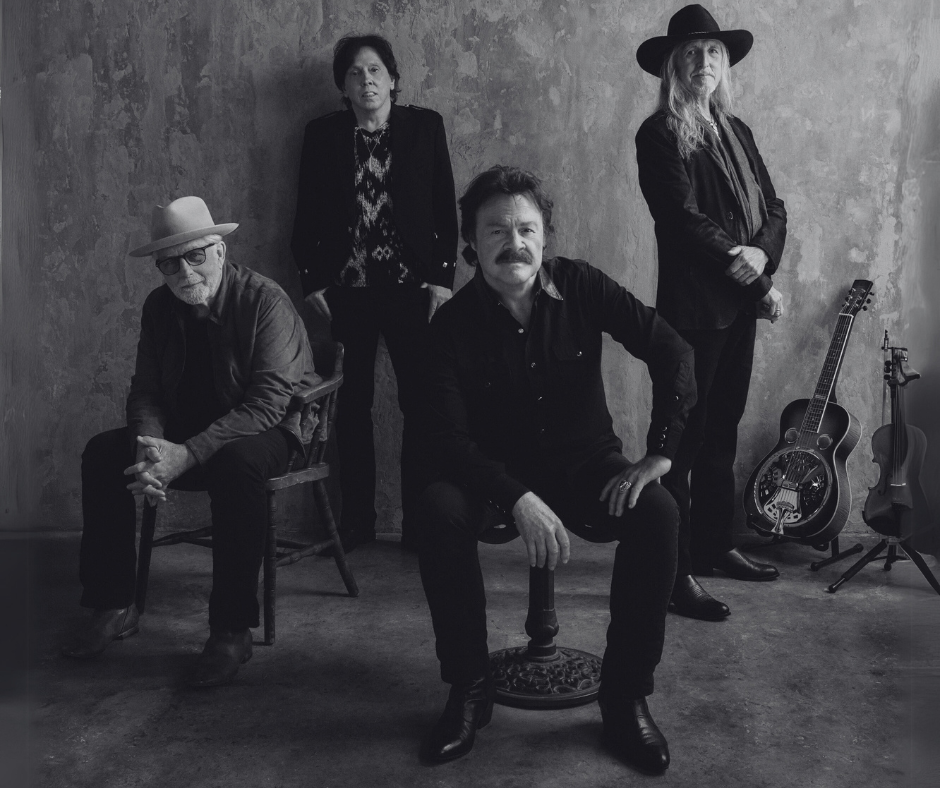The Doobie Brothers
[slideshow_deploy id=’718′]
As one of the most popular Californian pop/rock bands of the ’70s, the Doobie Brothers evolved from a mellow, post-hippie boogie band to a slick, soul-inflected pop band by the end of the decade. Along the way, the group racked up a string of gold and platinum albums in the US, along with a number of radio hits like “Listen to the Music,” “Black Water” and “China Grove.” The roots of the Doobie Brothers lay in Pud, a short-lived Californian country-rock band in the vein of Moby Grape featuring guitarist/vocalist Tom Johnston and drummer John Hartman. After Pud collapsed in 1969, the pair began jamming with bassist John Shogren and guitarist Patrick Simmons. Eventually, the quartet decided to form a group, naming themselves the Doobie Brothers after a slang term for marijuna. Soon, the Doobies earned a strong following throughout
Southern California, especially among Hell’s Angels, and they were signed to Warner Bros. in 1970. The band’s eponymous debut was ignored upon its 1971 release. Following its release, Shogren was replaced by Tiran Porter and the group added a second drummer, Michael Hossack for 1972’s Toulouse Street. Driven by the singles “Listen to the Music” and “Jesus Is Just Alright,” Toulouse Street became the group’s breakthrough. The Captain and Me (1973) was even more successful, spawning the Top 10 hit “Long Train Runnin'” and “China Grove.” Keith Knudsen replaced Hossack as the group’s second drummer for 1974’s What Once Were Vices Are Now Habits, which launched their first number one single, “Black Water,” and featured heavy contributions from former Steely Dan member Jeff “Skunk” Baxter. Jeff “Skunk” Baxter officially joined the Doobie Brothers for 1975’s Stampede. Prior to the album’s spring release, Johnston was hospitilized with a stomach ailment, and was replaced for the supporting tour by keyboardist/vocalist Michael McDonald, who had also worked with Steely Dan. Although it peaked at number four, Stampede wasn’t as commercially successful as its three predecessors, and the group decided to let McDonald and Baxter, who were now official Doobies, revamp the band’s light country-rock and boogie. The new sound was showcased on 1976’s Takin’ It to the Streets, a collection of light funk and jazzy pop that resulted in a platinum album. Later that year, the group released the hits compilation, The Best of the Doobies. In 1977, the group released Livin’ on the Fault Line, which was successful without producing any big hits. Johnston left the band after the album’s release to pursue an unsuccessful solo career. Following his departure, the Doobies released their most successful album, Minute By Minute (1978) which spent five weeks at number one on the strength of the number one single “What a Fool Believes.” Hartman and Baxter left the group after the album’s supporting tour, leaving the Doobie Brothers as McDonald’s backing band.
Following a year of audition, the Doobies hired ex-Clover guitarist John McFee, session drummer Chet McCracken and former Moby Grape saxophonist Cornelius Bumpus and released One Step Closer (1980), a platinum album that produced the Top Ten hit “Real Love.” During the tour for One Step Closer, McCracken was replaced by Newmark. Early in 1982, Doobie Brothers announced they were breaking up after a farewell tour, which was documented on the 1983 live album, The Doobie Brothers Farewell Tour. After the band’s split, McDonald pursued a successful solo career, while Simmons released one unsuccessful solo record. In 1987, the Doobies reunited for a concert at the Hollywood Bowl, which quickly became a brief reunion tour; McDonald declined to particpate in the tour. By 1989, the early ’70s lineup of Johnston, Simmons, Hartman, Porter, and Hossack, augmented by percussionist and former Doobies roadie Bobby La Kind, had signed a contract with Capitol Records. Their reunion album, Cycles, went gold upon its summer release in 1989, spawning the Top Ten hit “The Doctor.” Brotherhood followed two years later, but it failed to generate much interest. For the remainder of the ’90s, the group toured the US, playing the oldies circuit and ’70s revival concerts. By 1995, Michael McDonald had joined the group again and the following year saw the release of Rockin’ Down the Highway. But the line up had once again shifted by the turn of the new millennium. 2000 saw the band — Michael Hossack, Tom Johnston, Keith Knudsen, John McFee, and Pat Simmons — issue Sibling Rivalry, which featured touring members Guy Allison on keyboards, Marc Russo on saxophone, and Skylark on bass.
Biography by Stephen Thomas Erlewine
Soundtrack/Filmography
- Rail Kings (2005) (V) (performer: “Long Train Runnin'”)
- House of D (2004) (performer: “China Grove”)
- Radio (2003) (performer: “China Grove” (1973))
- “Six Feet Under”
- I’m Sorry, I’m Lost (2003) TV Episode (“It Keeps You Running”)
- Joe Dirt (2001) (performer: “Listen To The Music”, “China Grove”)
- A.K.A. The Adventures of Joe Dirt (Canada: English title: TV title) (USA: working title)
- Outside Providence (1999) (performer: “Long Train Runnin'”)
- The Limey (1999) (performer: “China Grove”)
- Forrest Gump (1994) (performer: “It Keeps You Runnin'”)
- Fire in the Sky (1993) (performer: “Black Water”)
- Frankie and Johnny (1991) (performer: “What A Fool Believes “)
- A.K.A. Frankie & Johnny (USA: poster title)
- Crooked Hearts (1991) (performer: “China Grove”)
- Stone Cold (1991) (performer: “Dangerous”)
- Field of Dreams (1989) (performer: “China Grove”)
- Personal Best (1982) (performer: “What A Fool Believes “)
- “What’s Happening!!”
- Doobie or Not Doobie: Part 2 (1978) TV Episode (performer: “Black Water”, “Takin’ it to the Streets”)
- Doobie or Not Doobie: Part 1 (1978) TV Episode (performer: “Little Darling (I Need You)”)
- The Squeeze (1977) (performer: “Listen To The Music “, “Cotton Mouth “)
- Filmography links and data courtesy of The Internet Movie Database.

